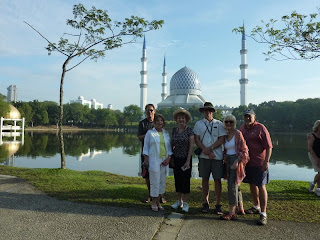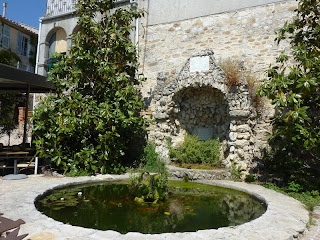We received our wake-up call at 6:15 a.m. for our nine-hour, ship-sponsored tour to Kuala Lumpur (from here on abbreviated as KL), which included three hours for the trip to and from the city. Once again we boarded an absolutely gorgeous bus. The United States should definitely hire decorators from Thailand and Malaysia to design their tour buses. We were delighted with the gold pleated draperies and tasseled valances, the burgundy with bright colored designed seats, and the use of that material on the ceilings and around the vents and light fixtures.
Our tour guide Suzy was wonderful and would keep us abreast of how far women have progressed in the third-largest Muslim country in the world (Morocco is first while Istanbul is second). We learned that Malaysia did not suffer from earthquakes, tsunamis or volcanoes. The biggest threat was the heavy rainfalls that caused flooding at the end of the year. The temperatures were hot, hotter and hottest. Friday was the holy day. While some countries do not allow women in the mosques because beautiful women, even with veils, could distract the men, Malaysian mosques at least had a separate section for women. However, a woman should not expose any part below her knee to the other sex in a mosque. But the ladies do wear very colorful clothes.
What turned into a warning flag for us was that Suzy did mention her government more than usual, which reminded us of our trip in China. She also told us about a male friend from another country, where the men could only see the eyes of a woman, who told her that he could tell if a woman was pretty from her eyes. But after he chose, there are no refunds.
The major sources of export income for Malaysia were petroleum, television and radio semiconductor components, and palm oil. Gas was cheap so most households in Malaysia owned an average of 2.5 cars that they purchased through nine years of installment payments. Between 30 and 40 percent of the land was cultivated for palm trees with four pounds of fruits producing one pound of palm oil, which is used for cooking and cosmetics. The country suffers from a shortage of sugar, and Malaysians liked to eat very sweet desserts and use at least two spoons of sugar in their cups coffee and tea. While timber used to be exported, the country was running out of timber so it was now expensive to live in a wooden house. Malaysia used to be one of the world's largest exporter of tin but now it was running out of tin. Alcohol and cigarettes were very costly because of the heavy taxes by the government, plus as a Muslim country, drinking was discouraged.
Education was free with most thinking it was an offense to the government if families did not sent their children to school. In the past, the students used to go abroad for their university education but now many go to the universities run by the government in Malaysia, which offered four-year degrees. When Suzy's bother went to the United States for his university education, he drank beer like water. Suzie finished her university education in Australia and New Zealand.
Most Malaysians did not speak English until they were forced to do so. If dealing with the government, one should speak Malaysian because the government would put a person on hold if he or she did not. If a person spoke English, that person was considered "stuck up." The government encouraged citizens to own homes with the a 500-square-foot home averaging about $4,500 US. The average family income was between $3,500 and $4,500 US with many citizens wanting to achieve a $10,000 US annual income.
Suzy described KL as being a concrete forest. Our first stop was the National Museum, which traced Malaysia's history from the Stone Age to when the Dutch arrived in the 1600s to when it was British colony for a century until 53 years ago when the country declared its independence from Great Britain. Then we drove to the National War Memorial where Suzy told us that the government does not allow the citizens to speak too much. The memorial was dedicated "to our glorious dead" from World War I and II and from the communists from 1948 to 1960. The National Monument which was "dedicated to the heroic fighters in the cause of peace and freedom," was dedicated to the heroes who fought during the Japanese occupation and communism. The monument featured five soldiers with the two fallen soldiers being communists. "May the blessing of Allah be upon them."
Suzy told us about her grandmother who lived during WWII and did not want to be captured by the Japanese and sold into slavery. In a coffee shop, she found a man to marry her who told her that he was very rich. Three days after the wedding, he asked her to return the wedding ring because he was not rich and had borrowed the ring. The grandmother tried to run away from him but broke her leg in the process. Eventually she became pregnant and had nine children.
We stopped at the railway station. The architect from England had been asked why the roof of the station was built that way. How could it endure the heavy snow? (Not a concern in Malaysia.) We also saw Independence Square and Club 125, celebrating its 125th anniversary. This club was started for white men only. The English ladies used to walk their spotted dogs around the club in search of their husbands. We saw the Anglican Church that was built in 1903 and then drove through Chinatown and Little India, where the government did not want to demolish the buildings because of their culture but sometimes only saved the front facades. We viewed the Petronas Twin Towers in the city center. A bridge connected the two towers with visitors starting to line up at 2 a.m. to cross it. At 452 meters high, these building were the tallest in Malaysia and the third tallest in the world. In Malaysia, transporting drugs and murder resulted in the stiff penalty of being hung until dead. While the king can grant a pardon, very few pardons have been given. One of the signs in the downtown area warned us to "Beware of Snatch Thief." The cutout on the sign was a woman whose purse was being snatched.
Suzy told us to eat lunch with our hands because touching the food with our fingers causes the fingers to send signals to our brains that make the food taste better. Our last stop was the 276-meter KL Tower built in 1996. At the top, we enjoyed panoramic views from 12 different points. When we tried to match up the buildings at the 12 points on the audio tour, we realized that the maps has been created when the tower was open and much had been changed since then. KL was a work in progress.


















































